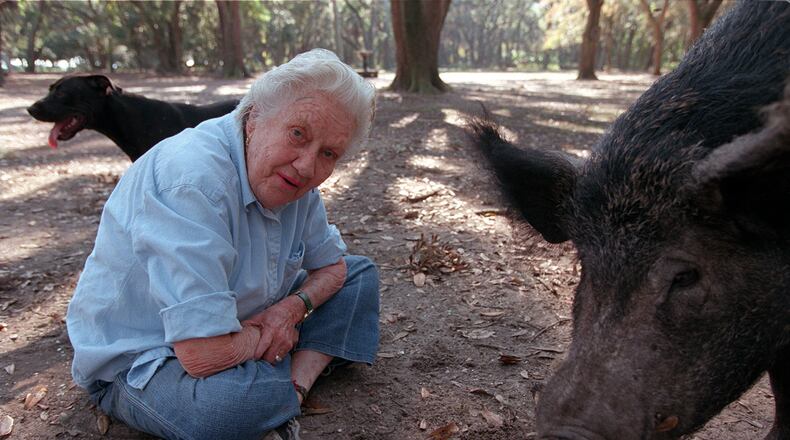Sandy West, the heiress-turned-conservationist who sold the 26,000-acre Ossabaw Island to Georgia so it could be preserved, died last month on her 108th birthday.
Born Eleanor Ford Torrey but known to her friends as Sandy, West was Ossabaw’s longest modern resident, living there for three decades until 2016, when declining health and funds forced her into a nursing home near Savannah.
West plowed nearly all of her once-considerable fortune into conserving the largely untouched Ossabaw, located about 20 miles south of Savannah. Accessible only by boat and for decades only to invited guests, the island is known for its golden saltwater marsh, grand oak trees, wild boar population and slave cabins made with an oyster shell concrete called tabby.
“Ossabaw Island as we know it exists because of Mrs. West, and Georgia is a better place because of her life’s work,” said Elizabeth DuBose, the executive director of the Ossabaw Island Foundation.
West grew up a debutante in Grosse Pointe, Michigan, a wealthy suburb of Detroit. Her father Henry was a surgeon and her mother Nell an heiress to the fortunes of Pittsburgh Plate Glass Company and Wyandotte Chemicals Corp.
The Torreys bought Ossabaw for $150,000 in 1924 after their previous winter retreat in Savannah burned down.
West told The Atlanta Journal-Constitution that the island, roughly twice the size of Bermuda, was considered at the time to be “a real white elephant” in an era when wealthy northern industrialists were snapping up their own barrier islands along the Georgia coast. The Torreys quickly built a 20,000-square foot Spanish colonial revival mansion, which they stuccoed in pink and adorned with wrought iron balconies, mahogany beams and Portuguese tiles.
Credit: Photo by Curtis Compton/staff
Credit: Photo by Curtis Compton/staff
West inherited Ossabaw in 1959 after her parents and brother died. Two years later, she and her second husband, Clifford Bateman West, founded the Ossabaw Island Project, an artist’s colony where painters, scientists, writers and other intellectuals could hone their crafts.
The retreat attracted writers such as Margaret Atwood, Ralph Ellison and Atlanta’s Olive Ann Burns, as well as the composer Samuel Barber, sculptor-designer Harry Bertoia and architect Robert Venturi.
It was around that time that West’s friendship with Eugene Odum, a respected University of Georgia ecologist, sparked her interest in the environment and conservation — a passion that shaped the rest of her life and the island’s fate.
West launched the Genesis Project in 1970, which invited college students and others to live off the grid in treehouses and sustainable cabins while working on projects in the sciences and the arts.
Credit: AJC
Credit: AJC
She was a wildlife lover who stored crackers in her bedroom so she could reach out her window to feed the birds. She kept two wild pigs as pets, Lucky and Mrs. Musgrove, believed to be descendants of the pigs brought to Ossabaw by Spanish explorers.
Beryl Gilothwest, West’s grandson, told The New York Times that West would walk Lucky around the island, “and then he would lie down on a riverbank, and she’d lean her head on his belly and read a book.”
Money, however, became a nagging problem. West was spending hundreds of thousands of dollars on food, staff and boats to ferry guests each year. She didn’t have enough to pay the island’s property taxes.
For years she wrestled with what to do. Aristotle Onassis and wife Jackie Kennedy Onassis offered to buy it sight unseen, the AJC reported. Developers envisioning another Hilton Head also approached her.
But West was insistent that the island stay undeveloped. She turned to Jimmy Carter, the former Georgia governor who was then a newcomer at the White House.
Credit: AJC
Credit: AJC
Carter spent two days at Ossabaw brokering a deal that would have West sell the island to Georgia for half of its $16 million appraised value — forgoing what would have been a considerable payday for West had she sold to developers. Taxpayers would put up $4 million and Coca-Cola’s Robert Woodruff would match it.
“Ossabaw is still in pristine condition because (Sandy) is a fighter,” Carter told the AJC in 2016.
As part of the agreement, the state, which took over in 1978, agreed to limit development and public access — including ferries, paved roads or airstrips — and allowed West to live in the family manse until she died.
Ossabaw is Georgia’s first Heritage Preserve, which restricts its use to scientific and cultural study, research and education, and preservation and conservation.
The Ossabaw Island Foundation will now take control of West’s mansion. Georgia’s Department of Natural Resources manages the land.
Less clear was what sort of public recreation was to be allowed — West believed it would be the “kiss of death” for Ossabaw’s natural splendor.
Credit: Photo by Curtis Compton/staff
Credit: Photo by Curtis Compton/staff
West closed the artists’ colony and the Genesis Project in 1982 as her financial challenges continued. In 2016, a GoFundMe account was set up to cover her home health care costs as her medical condition worsened. Later that year, at age 103, West moved to the mainland after the bills for around-the-clock care became insurmountable.
In a 1975 letter to her husband and children, West wrote that she wanted to be buried near the Middle Place, a former rice plantation on the isle, in a plain wooden coffin so she could officially become a part of Ossabaw’s rich, fertile soil.
“I so want to be part of the earth which I do so love,” she told the AJC.
Credit: AJC staff
Credit: AJC staff
West is survived by three children and eight grandchildren.
The family is postponing a memorial due to the pandemic. In lieu of flowers, they are asking for well-wishers to donate to the Humane Society for Greater Savannah.
Former AJC staff writer Dan Chapman and The New York Times contributed to this article.
About the Author
Keep Reading
The Latest
Featured


